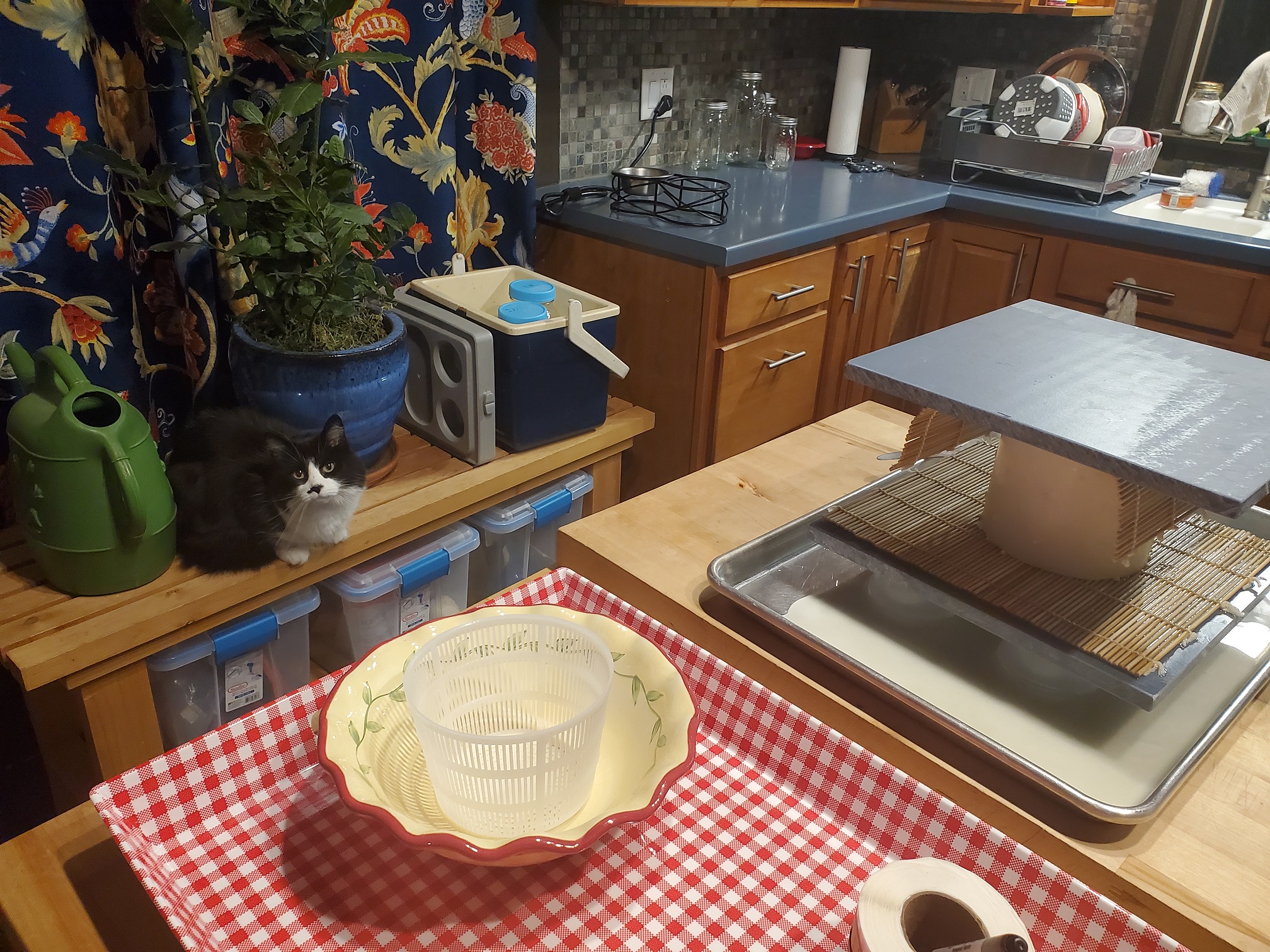If you have an Instant Pot or similar cooking appliance that has a Yogurt function, you may use it to make cheese! My preferred cheeses to make are Brie and its cousin Camembert, along with Gouda and Gruyere because the initial heating of the milk to 90 °F is right about where my Instant Pot heats when using the Yogurt setting. (You could probably make any kind of cheese this way, but I have not yet done it so I can’t say for certain that it works – but it probably does.) I also like to make Brie or Camembert because 1) these cheeses do not require a cheese press, 2) the white mold that develops on the cheese discourages any unwanted mold from developing, and 3) they are economical to make. The skill level for all these semi-hard and hard cheeses are considered “intermediate” not because there is any difficulty in their making, but because they require a time commitment for draining, pressing (Gouda, Gruyere), flipping, checking and removal of external unwanted mold, and aging upwards of 3 months or more.
There are other methods to heat your milk: on the stove and in a sink full of hot water. These both have obvious disadvantages. Heating milk directly on the stove requires constant attention and stirring in order to avoid burning the milk on the bottom of the pot. Heating milk in a hot water bath also requires constant attention to monitor temperature and add more hot water when needed. Some cheesemaking websites suggest that you put a smaller pot of water on the stove to boil water, and then place your larger pot with your milk on top of the smaller pot, making a type of steam boiler that is very tall and top heavy. What could possibly go wrong with that, eh? (sarc)
My Instant Pot is a “set it and forget it” kind of process that lets me go and do other things during the milk heating – culturing – curd formation process which takes about 3.5 hours total.
Note that cheese making is a multi-day process. What I am describing to you is what I do on the first half of Day 1 to warm, culture, and form curd with rennet.
I have one extra half-gallon of raw milk every week and I can make one 8-oz Camembert (2 quarts = one half-gallon, which yields one 8-oz cheese). My little 3-quart Instant Pot is just perfect for this small sized cheese and my small family can easily eat one 8-oz cheese per week.
Recipes are available for free on the New England Cheesemaking site at:
https://cheesemaking.com/.
You can modify any cheese recipe for smaller amounts of milk. You just need to reduce the amount of culture, mold and rennet proportionately. Also, when using raw milk, you may also further reduce your culture and rennet by 25-50%1 This will save you money; however, in my experience if you do not want to use smaller amounts, using the amounts called for in the recipe for pasteurized milk won’t hurt anything, you will just need to buy more culture sooner which is an economic issue, not a cheesemaking issue. For example, reducing the amount Geotrichum candidum (white mold) from 1/64 tsp (which is what the recipe lists for a 2-quart batch of Brie or Camembert) to 1/128 tsp (because I’m using raw milk) won’t work for me because I don’t have a measuring spoon small enough for 1/128 of a teaspoon. So I just go with what I have (1/64 of a teaspoon).
I am starting at noon because my milk pickup schedule for my herd share is at 11:00 slow time. (When I moved to the UP, I learned that the term “slow time” is a UP expression for central time. I am learning quite a bit about UP “culture” living “UP” here!)
For my Camembert, I’m using a recipe for a 2-gallon Camembert in my book “Home Cheese Making” by Ricki Carroll, and I’m using raw milk from my herd share.

Because I’m only going to make 2-quarts and not 2-gallons I have to do some simple math:
4 quarts = 1 gallon
8 quarts = 2 gallons
2-quarts/8-quarts = 1/4
So, a 2-quart batch is 1/4 of the recipe. Then I know to reduce the amount of culture, mold, and rennet proportionately by 1/4 as follows: buttermilk culture is 1/8 tsp, Penicillium candidum (white mold) is 1/16 tsp, Geotrichum candidum (white mold) is 1/64 tsp and rennet is 8 drops. (It’s also helpful to note that on the previous page of my book “Home Cheese Making” there is a recipe for a 2-quart Petit Brie. Since Brie and Camembert are similar, I just use the amounts listed on Brie recipe. Easy peasy!).
Sanitize Step: Now its time to start by sanitizing all the equipment that will come into contact with the milk. I use hot, soapy water that has sanitizer in it, then I rinse with hot tap water. You could also boil your equipment for 10 minutes just like you do when hot water bath canning. (Notice my favorite cooking tool in the picture? It’s a silicon spoon with a thermometer built right into it. It comes in handy for all sorts of cooking where temperature monitoring is necessary. It will let me know when a pre-set temperature is reached.)

Dry your Instant Pot inner liner and place it in your Instant Pot. Then pour the 2-quarts of milk into the Instant Pot inner liner and press the Yogurt button. If you are using pasteurized milk, you would also need to add calcium chloride to the milk. This is necessary because pasteurization erodes the calcium in the milk, weakening the walls of protein2 and this makes a weak curd. My experience is that raw milk produces the best curd for cheese making – no weaklings at all!


CAUTION: the Yogurt function of your Instant Pot does two things: It will scald your milk, basically pasteurizing it before you add any culture, and it will slowly heat your inoculated milk at a low temperature. Make sure your Instant Pot is set to the “less” setting like this for low and slow heating:

It takes 25 minutes for my Instant Pot to heat up 2-quarts of chilled milk to 90 °F. While the milk is heating, I can go do other things because I know that the Instant Pot will not overheat the milk.
Curd Ripening Step: After the milk has reached the Instant Pot temperature for Yogurt (around 90 °F), it is time to add the culture and molds and give the milk a gentle stir. It is helpful when using freeze dried culture to let the culture rehydrate for 2 minutes undisturbed in the milk before stirring. (Note: rennet addition comes later). Keep your Instant Pot “on” and set on the Yogurt “less” setting. I set the timer on the Instant Pot to 1 hour 30 minutes (or 90 minutes) which is how long you will let the milk with culture ripen. (Note that your Instant Pot will hover around 94 °F, which is fine.) While the milk and culture ripens for 90 minutes, I can go do something else. My Instant Pot will beep when the time is up.
Now would be a good time to set up your drain pan, drain board, bamboo mat and cheese mold. You need to be ready to ladle your curd into the cheese mold when your Instant Pot beeps at the end of the Curd Formation Step which happens right after the Curd Ripening Step.
Curd Formation Step: After the 90-minutes is up, it is time to add the rennet, give it a gentle stir, and let the milk sit for another 90 minutes while the rennet does its job. You will know when the rennet has finished doing its job when you get a “clean break”. It should look like firm, cooled gelatin, and when it is split open with a knife, it should look like this:

If you do not get a clean break, give the rennet more time to do its work. Since I did not further reduce my proportion of rennet due to using raw milk, the 8 drops I put in should work nicely in 90 minutes and I would be surprised if it needed more time to set.
You are now ready to ladle your curd into the cheese form and start the draining process. Use a slotted spoon to skim off curd about ½ inch in thickness and layer it evenly in your mold. Keep building up the curd in the mold until it reaches the top.




You will probably have more curd than space in your cheese mold. I have found that fresh raw milk produces the best curd for cheesemaking and I frequently have too much for my cheese mold. That’s ok. You can let the curd drain a little to make more room at the top and then add more curd. (You can also put the extra curd into a ricotta draining basket, let it drain until it has the consistency of soft mozzarella, and make yourself a little treat. YUM!)

So, that’s all there is to it! And with the help of my trusty Instant Pot, I’m able to make small batch, high quality, raw milk cheese efficiently in my kitchen all year round. Stay tuned for next time, when we drain (boring), flip (exciting!), salt and dry the cheese.
1Home Cheese Making by Ricki Carroll, page 7


8 responses to “Making cheese with your Instant Pot– 12.29.2022”
Thank you so much for sharing your expertise with us!
Thanks, Teri! It was my pleasure!
Great article. Very interesting.
Thanks for your kind words!
I am going to start learning how to make cheese this year from my Jorasz milk and eventually from our own goat milk. Thanks for sharing your process and helpful photos, Ivy!
Happy cheesemaking, Stacy! good luck and please let me know how it turns out.
Thank you so much for sharing these helpful instructions. I have been enjoying our Herdshare so much and love making cheese. I have greatly benefited from the book called The Art of Natural Cheesemaking by David Asher. I think you would enjoy it as well!
You are very welcome! I will check out your book recommendation. Thanks for the tip.